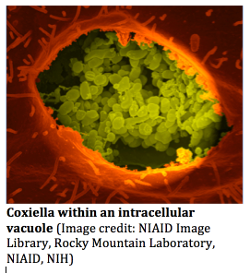VIVO Infectious Diseases
Biology of Coxiella burnetii
C. burnetii is a short, rod-shaped bacterium referred to as being Gram-negative, but which stains very poorly with Gram stain. It is an obligate intracellular pathogen in nature, replicating only inside cells. Recently, however, techniques have been developed to allow axenic or cell-free growth.

Within cells, the bacterium replicates inside membrane-bound structures called parasitophorous vacuoles. During the course of its development, two morphologically distinct forms of C. burnetii are observed:
- Small cell variant: This is the extracellular form released from infected cells that survives in the environment and infects animals. It exists as a spore-like particle has highly condensed chromatin and is quite resistant to adverse influences such as heat, drying and a number of disinfectants. After being taken up by host cells, the small cell variant develops into a large cell variant.
- Large cell variant: This form develops within cells after infection by a small cell variant. It is metabolically active and proliferates by division. After replication in the parasitophorous vacuole, the large cell variant transforms into a small cell variant to start the process again.
In addition to morphological variants, C. burnetii also exists in two phase variants based on the structure of its surface lipopolysaccharide (LPS):
- Phase I organisms (smooth form) are those isolated from infected animals and the environment, and are virulent (i.e. infect and cause disease). They are defined by having full length LPS.
- Phase II organisms are essentially non-virulent and arise during repeated passage of C. burnetii in cultured cells or chicken embryos. Their LPS is less that full length due to deletions of genes involved in LPS synthesis, and because of this genetic loss, Phase II forms cannot revert back to Phase I.
The type of LPS is the only virulence factor defined for C. burnetii. A full length LSP (phase I) is associated with an ability to induce disease in humans and animals, whereas Coxiella with a truncated LPS (phase II) do not usually cause disease in immunologically competent animals.
C. burnetii possesses a circular chromosome appoximately 2 Mbp in size. Nucleotide sequencing has led to classification of six genomic groups, referred to as I to VI. Additionally, all isolates of C. burnetii examined contain either an autonomously replicating plasmid or have plasmid sequences integrated into their chromosome. Again, there is genetic diversity in plasmid sequences and four distinct plasmid types have been characterized.
Updated 2022; send comments to Richard.Bowen@colostate.edu

